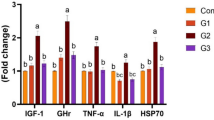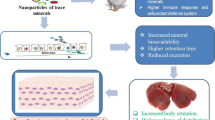Abstract
Present study was carried out to assess the significances of solid state fermentation of peanut oil cakes (POC) by Aspergillus oryzae on in vitro bioavailability of minerals (iron, zinc and calcium) and cellular transport, retention and uptake from POC through Caco-2 cells. Bioavailability of iron, zinc and calcium of POC was examined by means of a combined simulated gastrointestinal digestion/Caco-2 cell system. Bio-augmentation of minerals of fermented POC attributed a positive, statistically significant increased influence on minerals retention, transport and uptake values when compared with that of respective inorganic salts as reference. Results revealed increased cellular ferritin content from fermented POC digests than the digests of free form of respective inorganic salt. In prospect of the present investigation the fermented POC samples showed significantly higher iron, zinc and calcium bioavailability and enormous possible health benefits.




Similar content being viewed by others
Abbreviations
- SSF:
-
Solid state fermentation
- POC:
-
Peanut oil cakes
- AAS:
-
Atomic absorption spectrophotometer
- DMEM:
-
Dulbecco’s Modified Eagles Medium
- PBS:
-
Phosphate buffer saline
References
Adegbehingbe KT (2015) Effect of starter cultures on the anti-nutrient contents, minerals and viscosity of ogwo, a fermented sorghum–Irish potato gruel. Int Food Res J 22:1247–1252
AOAC International (2005) Official methods of analysis, 18th edn. AOAC International, Gaithersburg
Arya SS, Salve AR, Chauhan S (2016) Peanuts as functional food: a review. J Food Sci Technol 53:31–41
Camara F, Amaro MA, Barbera R, Clemente G (2005) Bioaccessibility of minerals in school meals: comparison between dialysis and solubility methods. Food Chem 92:481–489
Chancharoonpong C, Hsieh PC, Sheu CS (2012) Production of enzyme and growth of Aspergillus oryzae S. on soybean koji. Int J Biosci Biochem Bioinforma 2:228–231
Chawla P, Bhandari L, Sadh PK, Kaushik R (2017) Impact of solid state fermentation (Aspergillus oryzae) on functional properties and mineral bioavailability of black eyed pea (Vigna unguiculata) seed flour. Cereal Chem 94(3):437–442
Conrad M, Umbreit J (2002) Pathways of iron absorption. Blood Cells Mol Dis 29:336–355
Etcheverry P, Miller DD, Glahn RP (2004) A low molecular weight factor in human milk whey promotes iron uptake by Caco-2 cells. J Nutr 134:93–98
Fernando GL, Begon˜a OA, Carmen HB, Inmaculada BN, Bele´n PS, Silvia BG (2007) In vitro bioaccessibility of carotenoids and tocopherols from fruits and vegetables. Food Chem 102:641–648
Fleming MD, Trenor CC, Su MA, Foernzler D, Beier DR, Dietrich WF (1997) Microcytic anemia mice have a mutation in Nramp2, a candidate iron transporter gene. Nature Genet 16:383–386
Garcia-Nebot MJ, Barbera R, Alegria A (2013) Iron and zinc bioavailability in Caco-2 cells: influence of caseinophosphopeptides. Food Chem 138:1298–1303
Glahn RP, Rassier M, Goldman MI, Lee OA, Cha J (2000) A comparison of iron availability from commercial iron preparations using an in vitro digestion/Caco-2 cell culture model. J Nutr Biochem 11:62–68
Górnaś P, Rudzińska M (2016) Seeds recovered from industry by-products of nine fruit species with a high potential utility as a source of unconventional oil for biodiesel and cosmetic and pharmaceutical sectors. Ind Crop Prod 83:329–338
Guan G, Zhang Z, Ding H, Li M, Shi D, Zhu M, Xia L (2015) Enhanced degradation of lignin in corn stalk by combined method of Aspergillus oryzae solid state fermentation and H2O2 treatment. Biomass Bioenergy 81:224–233
Gupta RK, Gangoliya SS, Singh NK (2015) Reduction of phytic acid and enhancement of bioavailable micronutrients in food grains. J Food Sci Technol 52:676–684
Hidalgo IJ, Borchardt RT, Raub TJ (1989) Characterization of the human colon carcinoma cell line (Caco-2) as a model system for intestinal epithelial permeability. Gastroenterol 96:736–749
Hoz L, Ponezi AN, Milani RF, Silva VSN, Souza SA, Bertoldo-Pacheco MT (2014) Iron-binding properties of sugar cane yeast peptides. Food Chem 142:166–169
Jovov B, Wills NK, Lewis SA (1991) A spectroscopic method for assessing confluence of epithelial cell cultures. Am J Physiol 261:C1196–C1203
Kaushik R, Sachdeva B, Arora S, Kapila S, Wadhwa BK (2014) Bioavailability of vitamin D2 and calcium from fortified milk. Food Chem 147:307–311
Lane DJR, Merlot AM, Huang MLH, Bae DH, Jansson PJ, Sahni S, Kalinowski DS, Richardson DS (2015) Cellular iron uptake, trafficking and metabolism: key molecules and mechanisms and their roles in disease. Biochim Biophys 1853:1130–1144
Laparra JM, Glahn RP, Miller DD (2008) Bioaccessibility of phenols in common beans (Phaseolus vulgaris L.) and iron (Fe) availability to Caco-2 cells. J Agri Food Chem 56:10999–11005
Martin MP, Nepote V, Grosso NR (2016) Chemical, sensory, and microbiological stability of stored raw peanuts packaged in polypropylene ventilated bags and high barrier plastic bags. LWT Food Sci Technol 68:174–182
May PM, Williams DR, Linder PW (1978) Biological significance of low molecular weight iron (III) complexes. In: Sigel H (ed) Metal ions in biological systems, vol 7. Marcel Dekker, New York, pp 30–37
Miller DD, Berner LA (1989) Is solubility in vitro a reliable predictor of iron bioavailability? Biol Trace Elem Res 19:11–24
Nikolaus B, Peter ME (2015) Oxidative stress and the homeodynamics of iron metabolism. Biomolecules 5:808–847
Pendias AK (2004) Soil plant transfer of trace elements-an environmental issue. Geoderma 122(2–4):143–149
Pickardt C, Eisner P, Kammerer RD, Carle R (2015) Pilot plant preparation of light coloured protein isolates from de-oiled sunflower (Helianthus annuus L.) press cake by mild-acidic protein extraction and polyphenol adsorption. Food Hyd 44:208–219
Ramachandran S, Larroche S, Pandey A (2007) Oil cakes and their biotechnological applications–a review. Biores Technol 98:2000–2009
Shi A, Liu H, Liu L, Hu H, Wang Q, Adhikari B (2014) Isolation, purification and molecular mechanism of a peanut protein-derived ACE-inhibitory peptide. PLoS ONE 9:e111188. doi:10.1371/journal.pone.0111188
Snedecor GW, Cochran WG (1994) Statistical methods, 8th edn. Affiliated East-West Press, Iowa State University Press, Ames
Szlapka SE, Jarmolowska B, Krawczul S, Kostrya H (2009) Transport of bovine milk-derived opioid peptides across a Caco-2 monolayer. Int Dairy J 19:251–257
Tokuoka M, Sawamura N, Kobayashi K, Mizuno A (2010) Simple metabolite extraction method for metabolic profiling of the solid-state fermentation of Aspergillus oryzae. J Biosci Bioeng 110:665–669
Wang L, Hongzhi L, Liu L, Wang Q, Li S, Li Q (2017) Prediction of peanut protein solubility based on the evaluation model established by supervised principal component regression. Food Chem 218:553–560
Wiren N, Khodr H, Hider RC (2000) Hydroxylated phytosiderophore species possess an enhanced chelate stability and affinity for iron (III). Plant Physiol 124:1149–1158
Xiao Yu, Xing G, Rui X, Li W, Chen X, Jiang M, Dong M (2015) Effect of solid-state fermentation with Cordyceps militaris SN-18 on physicochemical and functional properties of chickpea (Cicer arietinum L.) flour. LWT Food Sci Technol 63:1317–1324
Zhang BS (2016) In vitro antithrombotic activities of peanut protein hydrolysates. Food Chem 201:1–8
Acknowledgements
The support by Department of Biotechnology, Chaudhary Devi Lal University, Sirsa, Haryana, India is gratefully acknowledged.
Author information
Authors and Affiliations
Corresponding author
Rights and permissions
About this article
Cite this article
Sadh, P.K., Chawla, P., Bhandari, L. et al. In vitro assessment of bio-augmented minerals from peanut oil cakes fermented by Aspergillus oryzae through Caco-2 cells. J Food Sci Technol 54, 3640–3649 (2017). https://doi.org/10.1007/s13197-017-2825-z
Revised:
Accepted:
Published:
Issue Date:
DOI: https://doi.org/10.1007/s13197-017-2825-z




